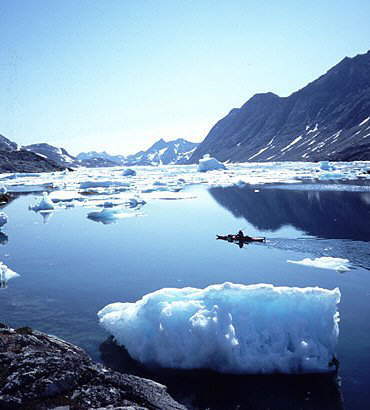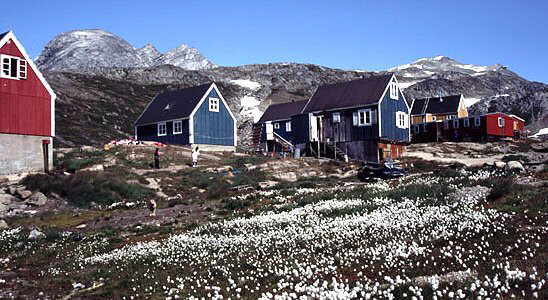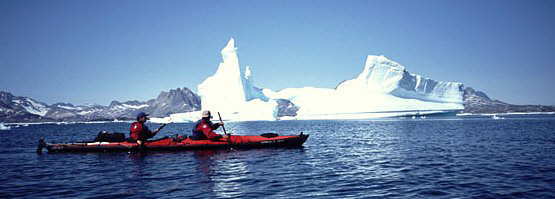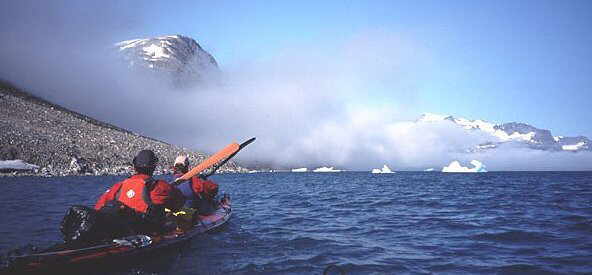
Wendy Killoran
The exhilaration of sitting in a kayak at the foot of an actively calving glacier got my adrenaline flowing and my heart thumping! As a paddler, I’d dreamt of paddling in Greenland, a paradise of ice, for a long time. An icy kingdom wondrously revealed itself to me as I paddled its fjords of ice. I’d paddled in a small group for almost two weeks in this realm of sculpted icebergs, drift ice, snow-capped serrated mountains, immense glaciers and sheltered fjords.
Our group of seven had already spent over a week paddling through a maze of fjords before reaching the Knud Rasmussen Glacier found at the terminus of the Sermiligaq Fjord just north of Kulusuk in East Greenland. We’d been blessed with warm, sunny, calm conditions for most of our adventure these last two weeks of July. In fact, who would have thought that daily highs would reach 27 degrees Celsius? Even mosquitoes wilted from the heat, and stayed tucked under cool leaves.
The bergy bits, drift ice and cathedral-like icebergs impressed us as evidenced by our infinite “oohs and aahs.” Sunshine glistened on these sculptures. The sun’s baking warmth caused extensive meltwater trickles to rain into the icy, inky water. Peering deep into this darkness, the berg’s base appeared like a turquoise apparition, diving deep below these blue and white sculptures of ice.
Often we wove single file through a maze of ice, which moved about at the whim of the currents, tide and soft whispering breeze. Pathways closed in upon us, causing us to retrace our path and to find a new route through this puzzle of ice.
To my delight, each iceberg or bergy bit is unique. The forces of nature, sun, wind, water, sculpt a one-of-a-kind creation. Mushrooms, castles, spires, holy cheeses, arches, triangulated slabs, ribbed platforms and circular holes captured my interest. Some were clear, others white, fewer were tooth-paste blue and even fewer were translucent crystal sapphire blue. I learned that the white icebergs appear white because air bubbles are trapped within which reflect white light. The bluer bergs are often younger (but not necessarily) and indicate a lack of air within. It was the blue bergs which mesmerized me.
Air becomes trapped within the ice with excessive accumulations of snow building up on the Greenlandic ice sheet. With enough weight, the snow is compressed into ice. As the thickness of the ice layer increases, it becomes viscous, flowing from the ice sheet through valleys as glaciers, eventually reaching the coast of Greenland at the terminus of a fjord, calving in all its dynamic wonder. It is the mountainous outside fringe of the coast which is habitable, and it was amongst these fjords, walled in by knife-sharp jagged grey mountains, where we kayaked. The picturesque villages, consisting of red, yellow, blue and green wooden homes, literally cling to these mountainsides above water’s edge.

Eighty-five percent of the island is covered in ice, which affects climate dramatically, making it quite apparent that the name Greenland is a huge misnomer. Exiled Eric the Red, a ruthless Viking, named this inhospitable place enticingly in order to trick and persuade others to come and settle here with him.
But Greenland had conjured up images of ice in my active imagination.
Every day, this adventure brought new surprises. Upon arrival, I’d watched an Inuit couple stretch a polar bear skin onto a driftwood frame. According to Inuit custom, the hunter who initially sees the bear has rights to the skin and half the meat. Polar bears, to my relief, were not usually found roaming the coast this far south during the summer months. It helped me sleep more restfully upon the aromatic carpets of tundra plants each night at camp.
The town of Kulusuk, meaning “bird breast” (as the imposing mountain next to the airport is rounded like a bird breast rather than being jagged like the surrounding peaks), was our starting point. Kulusuk is found in the Tunu District, or backside, of Greenland, a remote and sparsely populated area of the world’s largest island. Before venturing off by kayak on our day of arrival, we observed drum dancers perform, an art which has died out in most other regions of Greenland. Anna Kuitse was dressed in a sealskin anorak and shorts, with sealskin kamiks. She has been teaching youngsters in the village the art of this ancient Inuit tradition. Tinka Mikaelsen, a young adolescent girl with glossy, raven-black hair, clad in a white cotton anorak, red skirt and intricately beaded fringe necklace and headpiece, performed enthusiastically, with the stunning view of the Tuno Fjord served as a backdrop to this outdoor theater. Pili Maratse carried his handmade traditional kayak, driftwood frame covered in sealskin, to the rocky shoreline, where he removed his shoes and wiggled into his custom-fitting boat to demonstrate Greenlandic paddling techniques, including harpoon throwing, amongst a puzzle of drift ice. It was hard to imagine that the elderly villagers of Kulusuk had only emerged from a primitive stone-age existence since 1958, when Americans created the international airport and established a radar station here. Even now, infrastructure is minimal, with the majority lacking running water and most using a bucket for a toilet. (I watched my step carefully.) The chained sled dogs, fur matted and unkempt, are indigenous to this area, easily outnumbering the 350 villagers. The dogs should not be handled, unless one is willing to forfeit a hand!
As soon as we left the cove behind the hotel, we were immersed in a fantasyland of ice. We wove our way in fine zig-zag fashion in water corridors barely wide enough for the Feathercrafts (both K1 and K2s). But the Tuno Fjord was simply too congested with ice. We lunched on a small knoll of rock, and as the tide rose, the ice spread apart. The increased volume of water in the fjord helped create a greater surface area, and we continued making progress easily amongst the art gallery of unlimited ice sculptures.

We came across ancient ruins of homes on small promontories overlooking the Angmagsallik Fjord. I looked inside a burial chamber where a weathered human skull, encrusted with lichen, was believed to be at least six centuries old.
On our second day of paddling, we were halted by a fjord choked with ice. We camped in the beauty of a setting sun with a parade of bergy bits and drift ice gleaming. Although the sun doesn’t set in the height of the summer at 66 degrees north, the sun disappeared behind the towering peaks and the midnight sun kept the land alive in lambent hues.
Tides were a noticeable factor and ranged from three to four metres. We transported our kayaks well above the high tide mark. A rogue tidal wave could easily steal an unwary paddler’s boat and gear, caused by calving glaciers or icebergs. (Thankfully, I was paddling with a very reputable Icelandic tour company, Ultima Thule, as I was aware that another local kayak tour operator in the area was unreliable.)
One evening, we landed on a sandy beach, which we dubbed “Copa Cobana.” A lengthy crescent of beach sheltered in a stunning cove held a small hunter’s cabin and the perfect camping meadow, where an Arctic fox visited us at dinner. The water’s clear, turquoise hues could easily trick one into believing we were somewhere tropical, until one dipped one’s fingers into the bone-chilling, flesh-numbing water!
Another day, we paddled up a narrow fjord east of the colourful village of Kungmiut. The tide was rising and we came to a narrow height of land in this U-shaped valley traversable by kayak only at high tide. Water flowed up fjord until a narrow stream flowed against us. Here the Tuno Fjord flowed in the reverse direction. With umph and determination we paddled over this small divide. How strange and different to encounter two opposing water directions converging in one valley.
Slightly farther along, we visited the abandoned American Air Force Base, established during World War II to make aerial surveillance tours to find German submarines. The wide mountain side and valley was strewn with “American roses,” as our guide Gunnar Bjorgvinsson referred to the hundreds of thousands of rusted 50 gallon oil drums littering the ground. A collapsed hangar and numerous rusted trucks also scarred the scene, where a very useable airstrip lay unused for six decades now.
As we arrived at our campsite along the shore of Ikateq Fjord, tendrils of fog danced eerily amongst jagged peaks and a dense fog lay nestled on the Sermiligaq Fjord beyond. It all looked very austere and mysterious as icebergs floated in and out of view.

The trip built in momentum and continued to present us with outstanding moments. Camped near the Karale Glacier, the long, flat-angled beach was filled with a display of bergy bits and growlers, parked for up close, terrestrial viewing. Ice-blue glassy bergy bits balanced, translucent and captivating. Here we also huffed and puffed up a mountain to a viewpoint overlooking the Y-shaped Sermiligaq Fjord with two glaciers spilling into each branch of the Y, the Karale Glacier to the west and the Knud Rasmussen Glacier to the east. A curious Arctic fox hovered nearby, inquisitively following us.
Towards the end of our paddling journey, we paddled to the 100-metre tall, four-kilometre wide Knud Rasmussen Glacier, a very active glacier and very extensively crevassed as far as the eye could see. Ivory gulls sat at the precarious base. Did the glacier’s calving create easy fishing? For safety, we were instructed to stay back at least three times the height of the calving wall. We grouped en masse and listened to growls and rumbles followed by clouds of icy white spray. We paddled eastward, in awe of the magnitude, the cacophony of roars and the alluring crevasses. Huge sections of the glacier wall were a vitreous icy blue with deep chasms split into this wall, resembling palatial chambers.
The rumbles, growls and thunderous roars increased in frequency. More and more sprays of sparkling white clouds burst into the mirror calm fjord below. Small tsunami waves ensued as larger chunks of ice spilled into Sermiligaq Fjord. And then a massive thundering bang released a sapphire blue chunk of ice the size of a multi-story apartment building. In slow motion it toppled over. A three-metre wave built at the foot of the glacier and rolled towards us. The fjord was alive with sounds and motion; slurps, sloshes and slaps accompanied by fast paddle strokes grabbing the water.
Bergy bits nearby danced wildly as swells lifted our kayaks several metres. A glacial soup invaded and engorged the fjord. Sharp, crystal clear shards of ice surrounded the icebergs, and often, the trapped air bubbles were released in loud snaps, crackles, and pops.
We retreated hastily, grinning foolishly but filled with reverence. The intensity of sitting at the base of a 100-metre tall glacial wall, calving mega chunks of glassy ice was pure exhilaration. Greenland was sharing its grandeur with us, in beauty and power.

We paddled vigorously along the icy line that raced deeper away from the glacier. We were silenced into a state of incredulous awe at the shore where we established camp near the glacier, named after Knud Rasmussen, an early zoologist and geologist, but also an Inuit-Danish Greenlander who researched Inuit culture and folklore extensively.
That evening I climbed above the glacier to gaze down upon this serpent of ice. The glacial valley converged with numerous tongues of ice and curved far to the northwestern horizon, flowing between mountains with needle-sharp summits to the interior ice sheet. The immensity surrounding me dwarfed me. The glacial soup had dispersed itself far and wide through the fjord.
How could the paddling expedition possibly get any better? But it did! We were a remarkably cohesive group with a fun sense of humour and we shared great camaraderie throughout the journey. Our final day of paddling was yet again under an intense sun with a mirror of water surrounding us. At our final campsite, on an island near the town of Sermiligaq, I went for a solo paddle into the fjord towards the wide-open ocean. The sun was low on the horizon, casting a honey golden light. I absorbed what I saw, heard, smelled and felt, letting it seep deep within. Magical light cast enchanting qualities of light on icebergs of exquisite detail. Clefts and pillars, turrets, spires and flowing appendages gleamed iridescent blue and turquoise with hints of gold. The fjord was silent with the occasional thrumming of a boat’s engine. Earlier, three heart-stopping blasts had reverberated over the fjord. Now a frenzy of yelps and howls and growls deafened the silence. Hunters had killed a seal to feed their sled dogs left to roam wild and free during the summer months on Leifs Island.
Later, our edible feast was followed by a feast for our eyes. As midnight approached, the sky transformed from yellow and orange to crimson and smoky purple, a slow motion display of luminous magnificence. As the fjord glowed, blotched by periwinkle icebergs motionless in the distance, the horizon was silhouetted by toothy, saw-like peaks. Our group yet again shared a moment of reverence. Greenland truly is a land of superlatives!
Greenland … a land of superlatives
